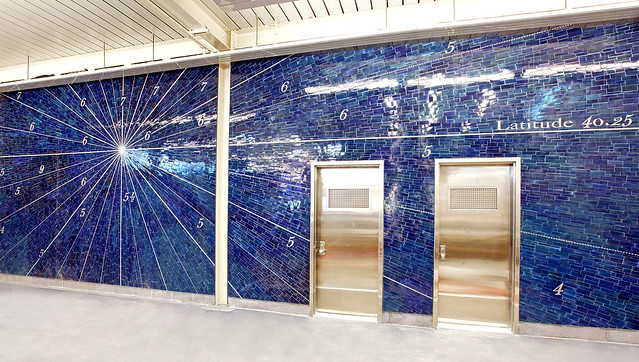
The system’s newest station will remain closed for a considerable amount of time. (Photo by Benjamin Kabak)
When last we checked in on the Sandy-ravaged South Ferry station, three months had elapsed since the storm, and the new southern terminal of the 1 train was in ruins. Work had yet to begin in earnest on the station reconstruction, and the photos were a stark reminder of the destructive power of salt water. Nearly every inch of the new station had been touched by the storm surge, and no one seemed to know when conditions would return to normal.
On the six-month anniversary of the storm, NBC News has again ventured underground to check out the conditions below the surface. Their piece — aimed at a national audience — rehashes a familiar story with with some small updates. Carlo Dellaverson offers up a tale of a station that needs to be rebuild nearly from scratch. “It’s a complete gut job,” MTA spokesman Kevin Ortiz said. “Every component of the station needs to be replaced.”
The NBC producer has more:
As communities rebuild and residents return to their homes, dozens of workers at the South Ferry station are taking the very first steps toward getting the station back online, starting with scrubbing mold from virtually every surface. Before the storm, 30,000 people passed through South Ferry each day, shuttling between Staten Island and Manhattan and around the labyrinthine streets of New York’s financial district.
Now, the stillness of the station is unsettling. The 90-foot platform sits empty, with strings of construction bulbs lighting two tracks and tunnel walls still covered with debris and dirt from the storm. Drywall and tiles have been ripped up by construction workers to expose the film of mold that quickly built up in the dark, humid space after the storm hit six months ago. The air is thick and pungent.
But the greatest damage inflicted from Sandy is not visible. The salty ocean water that flooded the station eighty feet below street level corroded nearly every piece of equipment in the space, adding considerably to the cost of recovery. Over 700 relay components – devices critical to the signaling systems of trains – were destroyed. A separate room of signaling equipment at the end of the platform flooded to the ceiling and is now a “complete loss,” said Joseph Leader, the Metropolitan Transportation Authority’s chief maintenance officer, who is overseeing the rehabilitation and reconstruction of the station.
The MTA has attached a $600 million price tag to the reconstruction efforts, but details on the timing and process are still being hashed out. When push comes to shove, the agency is likely to strip the station down to a bare cavern and start the construction process all over again. Engineers will have to figure out how to harden the station to protect against future storms and future storm surges, and straphangers will have to face the reality of the loop station for a few years at least.
For now, the top priority is mold abatement. When I was there in January, the smell of the water-logged station was pervasive. Soggy ceiling tiles marred crew rooms and fried computer equipment sat where the storm waters had deposited it. The recovery and rebuild will be substantial, and when it’s all over, the second round of $600 million spent at South Ferry should last longer than the first. Otherwise, we’ll just keep paying for this station with tax-payer dollars storm after storm after storm.


















